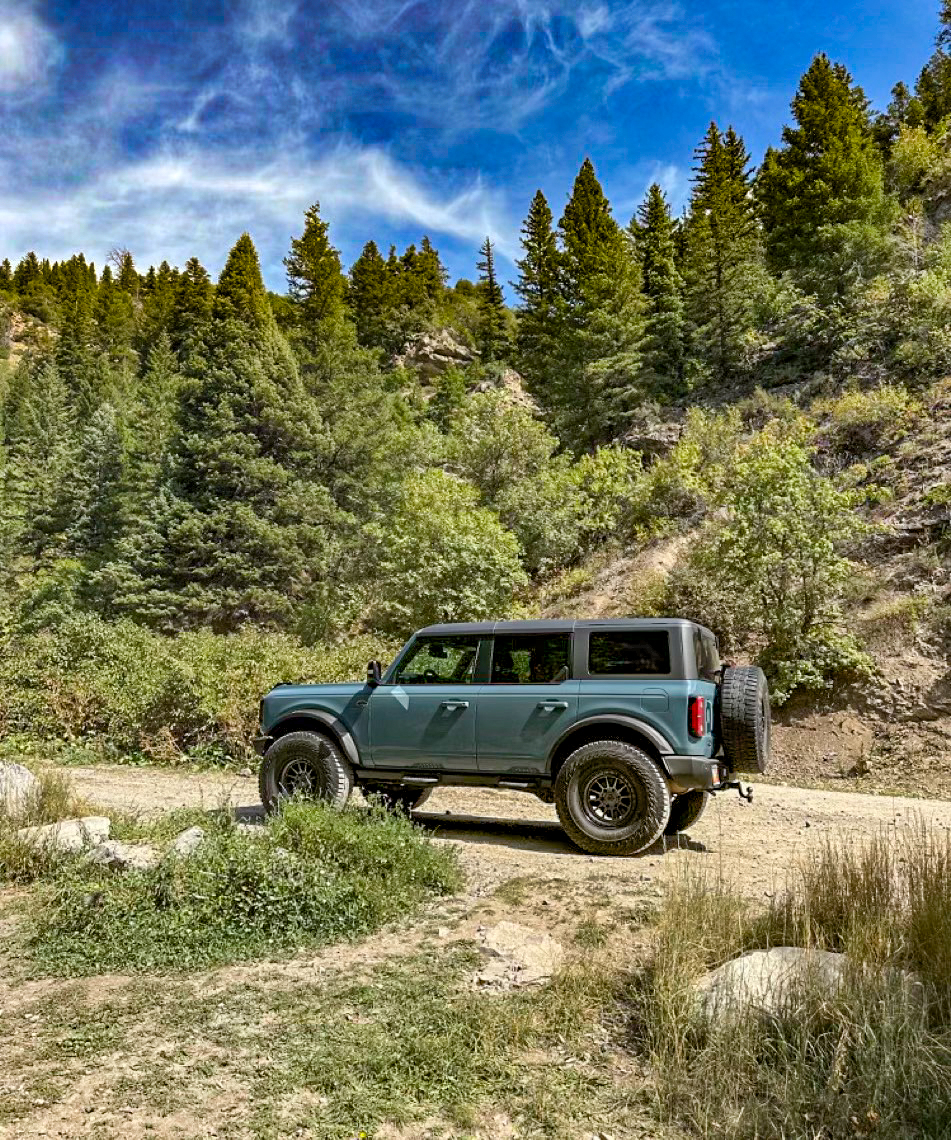Hey Bronco Nation! I’m Chuck Yarbrough and I’m an instructor at Bronco Off-Roadeo in Moab, UT. I’ve also had the great opportunity to visit a few Bronco Off-Roadeo Outpost locations such as Oregon, Michigan, and Pennsylvania. Seriously, there’s nothing more fun than hanging out with good people with similar passions.

Benefits of Reducing Tire Pressure Before Going Off-Road
One of the questions I get regularly is “What air pressure should I air down to?” Airing down your tires is a crucial technique for enhancing your vehicle’s performance on challenging terrain. Determining the pressure to air down to, well that isn’t so simple. Let’s first talk about the benefits of reducing tire pressure (airing down) before going off-road:
- Improved Traction: Lower tire pressure increases the surface area of the tire that contacts the ground. Doing this provides a better grip on loose terrain and surfaces like sand, mud, and rocks.
- More Comfortable Ride: Softer tires can absorb bumps and irregularities in the terrain, leading to a more comfortable ride. Reducing tire pressure aids your suspension in making the journey even more enjoyable for everyone, especially your passengers.
- Greater Floatation: Reducing the air pressure widens and elongates the tread pattern which allows the vehicle to ride on top of compressive surfaces like soft sand and snow much better than a fully inflated tire which has a much narrower surface area touching the ground.
- Reduced Risk of Tire Damage: Lower pressure allows tires to flex more, reducing the likelihood of punctures through the tread from sharp rocks. Having said this, the biggest risk to your tires is the sidewall. Watch out for “stick-out rocks” that can slice through your sidewalls. So be aware that lower psi in the tire lets the side wall poke out and become at risk.
Optimal Tire Pressure
So now we understand the reasons we should air down while off-road. So, what is the optimal air pressure? The simple answer is yes, there is an optimal number. However, that number depends on things like:
- What kind of tires are you running?
- What type of terrain is the trail we’re going on?
- What size tire are you using?
- What’s the weather and air temperature?
- What style of off-roading are we going to be doing?
Understanding each of these will enable us to come up with a good starting pressure. But even then, you’ll need to work through the terrain and see and feel how the tires perform at the selected pressure. What this means is that the optimal air pressure isn’t easy to determine. It takes time and testing. However, most of us just want to get out on the trail and go. So, here’s a way for you to simplify the process and come up with a viable path to begin off-roading. Let’s say you have a Bronco with the Sasquatch package on it. The tires from the factory are the Goodyear Territory MT’s and the size is 35” on a 17” wheel. On the manufacturer label on the door, the on-road air pressure is recommended at 39 psi. Knowing that we want to air down, I recommend that once on the dirt, start by dropping the air pressure by 10 lbs lower than the full inflation recommendation. On these tires, we’d air down to 29 lbs. Once at 29 psi, drive down the trail and feel how the tires work on the trail. If you feel like you’re not getting enough traction, and your tires are spinning too easily, try reducing the psi by another 10% (+- 2-3 psi). Continue this until you feel like you have enough traction. I wouldn’t advise going lower than 20 psi.
If the terrain you’re going to be on is deep sand (like a beach or sand dune) then you might want to start even lower than 29 psi. Perhaps start at 24 lbs and work lower if needed. In this situation, I feel you could go below the 20 psi, but I wouldn’t recommend lower than 15 for deep sand. Once out of the deep sand, consider airing back up to a higher tire pressure.

How Do I Air Down?
Airing down the first time can be a bit scary. However, it’s quite simple and can be even easier with the right tools.
Tools Needed:
- Tire Pressure Gauge: This is very helpful for accurately measuring tire pressure. Your Bronco has a display on the offroad menu system on the dashboard and will show the PSI at each tire. Make sure you give it a minute or two to refresh and show the changed pressure.
- Tire Deflator: A tool designed to quickly and easily release air from your tires. I use an ARB Tire Deflator which is very accurate and allows me to remove the stem and let the air out rapidly and then close it quickly to view the built-in pressure gauge for fine-tuning the air pressure. Also, the back of most stick-style air pressure gauges has a small point that can be used to push the stem in on the valve and let the air out. In a pinch, you can even find a rock or a stick to poke the stem.
Step-by-step Guide on How to Properly Air Down Your Bronco
- Check Air Pressure: Look at the dashboard screen for the air pressure of each tire or check with a handheld pressure gauge to verify each tire's PSI.
- Determine the Target Pressure: Decide what the optimal pressure is based on all the factors we’ve discussed above.
- Deflate Gradually: Use the deflator to release air but be careful to not go too far. Slowly allowing air out and checking the pressure often is better than going too far down and having to inflate back up to the target PSI.
- Monitor Regularly: Once on the trail, keep an eye on the air pressures of all 4 tires regularly to ensure something hasn’t caused further deflation.
Mastering Bronco Air Pressure Tips
When you get done with your trail drive, be sure to jot down the air pressure you used and what you felt. This will allow you to be more prepared for any trail that has similar terrain. Once you get comfortable with airing down, you will begin to understand the air pressure that works best for your vehicle and for the trails you use. It will become second nature and be a quick process at the beginning of every trail. Also, be aware you’ll need to air back up when you get back to the highway. Be sure you stay tuned for our next conversation about how you can easily air up and be safe back on road!

Comments
You must log in or register to post here.